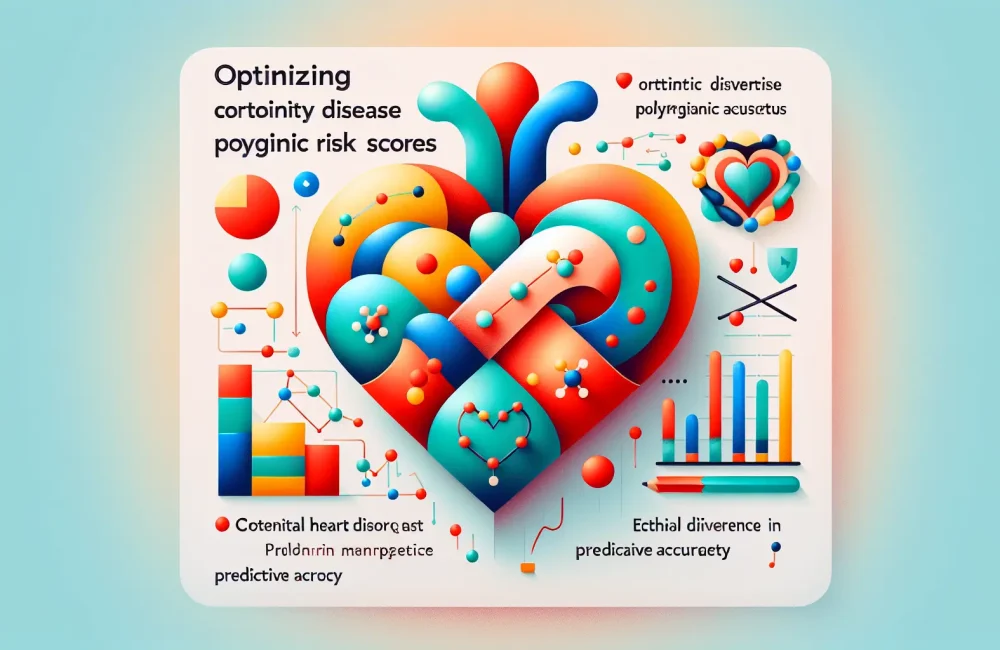By CAFMI AI From JAMA
Performance of CHD Polygenic Risk Scores Across Populations
Polygenic risk scores (PRSs) for coronary heart disease (CHD) have emerged as promising tools to improve cardiovascular risk prediction beyond traditional clinical factors. In this large cross-sectional study involving over 50,000 participants from diverse ancestries including European, African, and Hispanic backgrounds, several widely used CHD PRSs were evaluated for their ability to discriminate CHD risk and the agreement among them. The study found that these PRSs demonstrated moderate discrimination with area under the receiver operating characteristic curve (AUC) values ranging from 0.60 to 0.70. Notably, performance was highest in individuals of European ancestry, where the scores showed greater predictive accuracy, while the predictive power diminished in African ancestry populations. This disparity highlights important considerations regarding the calibration and applicability of existing genetic risk algorithms across different ancestral groups. Beyond discrimination, the correlation coefficients between different PRSs varied considerably from 0.5 to 0.85, indicating variability in how different genetic models classify risk within the same individuals. This variability stems largely from the heterogeneity in PRS construction, such as differences in the genetic variants included and the statistical methods used for developing each score. These findings have direct relevance to clinicians considering the integration of PRSs into cardiovascular risk assessment, suggesting that while PRS can add incremental predictive value, especially for European ancestry populations, caution is needed due to differences in score agreement and performance across ethnicities.
Clinical Implications and Limitations of Using PRSs for CHD Risk Stratification
From a clinical perspective, the addition of polygenic risk scores to traditional CHD risk factors yielded only modest improvements in risk prediction. This modest enhancement underscores the current limitations of PRS as standalone tools or as routine additions in everyday cardiovascular risk assessment practices. For U.S. healthcare professionals, who frequently encounter ethnically diverse patient populations, the lower predictive performance of PRSs in non-European groups is a critical consideration. It means that reliance on existing PRSs without adjustment or further validation could result in underestimation or misclassification of risk in these patients, with attendant implications for primary prevention strategies such as initiation of statins or lifestyle interventions. Additionally, the variability in agreement between different PRSs complicates their use in clinical decision-making, as different genetic scoring systems may yield inconsistent risk estimates for the same individual. This variability can challenge efforts to standardize genetic risk assessment workflows and may affect patient counseling and shared decision-making.
Future Directions and Best Practices for PRS Implementation in Practice
The study’s conclusions emphasize the need for ongoing research to enhance the utility of polygenic risk scores for CHD, particularly through efforts to standardize score development and validate them across diverse populations. Clinicians should be aware that PRSs are currently best used as adjuncts to, rather than replacements for, established risk assessment tools such as the Pooled Cohort Equations. Future guidelines may incorporate more refined polygenic risk algorithms as these are improved and validated with harmonized methods and datasets encompassing multiple ancestries. Moreover, patient counseling and management workflows should incorporate discussion of the limitations and uncertainties around PRS results, particularly around their reduced accuracy in non-European ancestries and the current variability between different scoring methods. Incorporating PRS into clinical practice will require concerted efforts in education for healthcare providers, availability of standardized and clinically validated PRS tools, and informed patient communication strategies. As polygenic risk prediction continues to evolve, primary care and cardiology clinicians should stay informed about advances to optimally integrate genetic risk profiling to enhance personalized prevention and management of coronary heart disease.
Read The Original Publication Here






